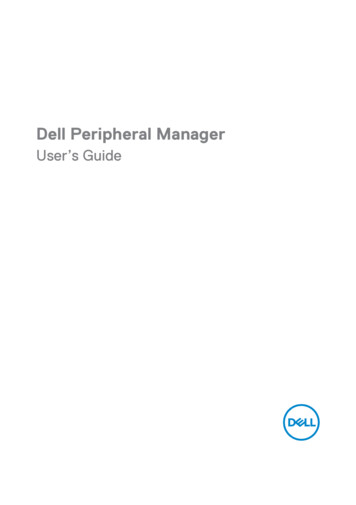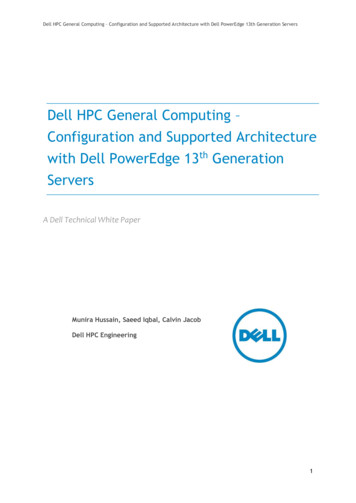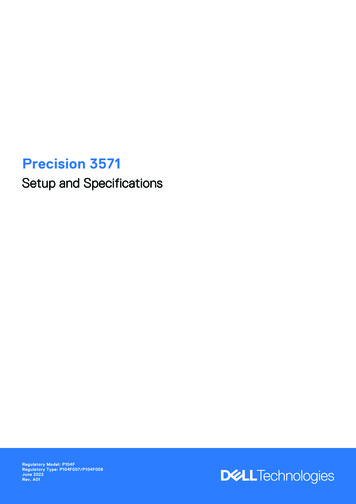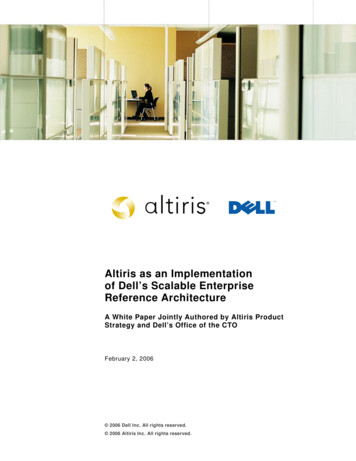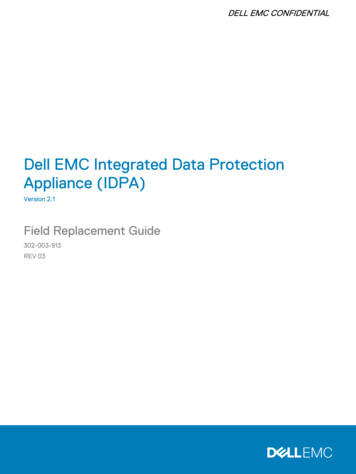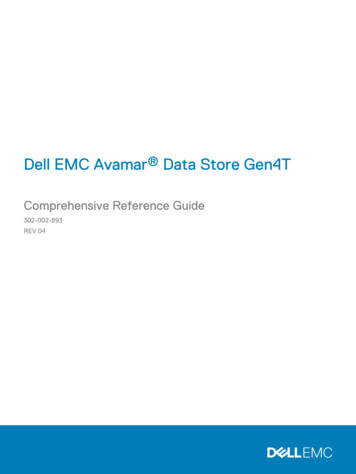
Transcription
Dell EMC Avamar Data Store Gen4TComprehensive Reference Guide302-002-893REV 04
Copyright 2016-2018 Dell Inc. or its subsidiaries. All rights reserved.Published July 2018Dell believes the information in this publication is accurate as of its publication date. The information is subject to change without notice.THE INFORMATION IN THIS PUBLICATION IS PROVIDED “AS-IS.“ DELL MAKES NO REPRESENTATIONS OR WARRANTIES OF ANY KINDWITH RESPECT TO THE INFORMATION IN THIS PUBLICATION, AND SPECIFICALLY DISCLAIMS IMPLIED WARRANTIES OFMERCHANTABILITY OR FITNESS FOR A PARTICULAR PURPOSE. USE, COPYING, AND DISTRIBUTION OF ANY DELL SOFTWARE DESCRIBEDIN THIS PUBLICATION REQUIRES AN APPLICABLE SOFTWARE LICENSE.Dell, EMC, and other trademarks are trademarks of Dell Inc. or its subsidiaries. Other trademarks may be the property of their respective owners.Published in the USA.Dell EMCHopkinton, Massachusetts 01748-91031-508-435-1000 In North America 1-866-464-7381www.DellEMC.com2Avamar Data Store Gen4T Comprehensive Reference Guide
CONTENTSChapter 1Introduction5Important Avamar terms and concepts.6Nodes. 6Node resource database (probe.xml).7Avamar Downloader Service. 7Local downloader service.7Avamar FTP site. 8Avamar Installation Manager. 8Avamar login manager. 8Packages. 8Segregated networks. 9ConnectEMC. 9Email home.10Data deduplication. 10Replication. 11Avamar clients. 11Encryption. 11Information for customers.12Fundamental Avamar principles. 12Avamar installation features overview. 12How long will the Avamar software installation take?.13Avamar Installation Manager. 13Process flow. 13Log files. 15In-flight encryption. 15Avamar Downloader Service.15Chapter 2Hardware specifications17Multi-node server component locations. 18Hardware specifications.19Utility node.19M600 (2.0 TB licensed capacity). 19M1200 (3.9 TB licensed capacity). 19M2400 (7.8 TB licensed capacity). 20Avamar Business Edition/S2400 node (7.8 TB licensed capacity).20NDMP accelerator node. 20Service port connectivity. 20Node components. 21Chapter 3Networking25Overview. 26Default port configuration. 26Multi-node servers. 26Single-node servers. 27Basic networking configuration. 28Multi-node servers.28Supported network configurations. 29Multi-node servers. 29Avamar Data Store Gen4T Comprehensive Reference Guide3
CONTENTSSingle-node servers.31Advanced network configuration – dpnnetutil utility.34Features provided by dpnnetutil.35Replication. 36Single-node servers. 36Multi-node servers.38Chapter 4Installation and beyond41Avamar "installation" process. 42Siting. 42Installation. 42Implementation. 42Everyday use of Avamar servers.42Maintenance of the server.434Avamar Data Store Gen4T Comprehensive Reference Guide
CHAPTER 1IntroductionThe following topics introduce Avamar and the Avamar Data Store (ADS) Gen4Tfamily of hardware components:lllImportant Avamar terms and concepts. 6Information for customers. 12Avamar installation features overview.12Introduction5
IntroductionImportant Avamar terms and conceptsAvamar solves the challenges associated with traditional backup, enabling fast, reliablebackup and recovery for remote offices, data center LANs, and VMwareenvironments.Avamar is backup and recovery software that uses patented global data deduplicationtechnology to identify redundant sub-file data segments at the source, reducing dailybackup data by up to 500x - before it is transferred across the network and stored todisk. This enables companies to perform daily full backups even across congestednetworks and limited WAN links.Key Avamar differentiators are:lDeduplication of backup data at the source - before transfer across the networklEnabling of fast, daily full backups across existing networks and infrastructurelReduction of required daily network bandwidth by up to 500xlUp to 10x faster backupslEncryption of data in flight and at restlPatented RAIN technology that provides fault tolerance across nodes andeliminates single points of failurelScalable grid architecturelReduction of total backup storage by up to 50x due to global data deduplicationlDaily verification of recoverability - no surpriseslCentralized web-based managementlSimple one-step recoverylFlexible deployment options, including the Avamar Data Store packageThe remainder of this section provides descriptions of key terms used in this guide andother Avamar core software guides.NodesA node is the primary building block in any Avamar configuration. Each node is a selfcontained, rack-mountable, network-addressable server that runs Avamar software onthe Linux operating system. All Avamar nodes are Domain Name System (DNS)clients.NoteThe term "server" in the previous definition is used in the typical industry context(that is, a computer that provides services to other computers or devices). However,for the remainder of this guide, unless otherwise specified, the term "server" refers toa single-node or multi-node Avamar system. The term "node" refers to the individualcomputer/storage platforms that make up an Avamar server.All nodes run the Linux operating system and use RAID data protection. Nodes have 2,4, 6, 8, or 12 hard drives, depending on node type and storage capacity. The primarydifferences between node types are:6lThe amount of internal data storage (if any)lThe configuration and allocation of internal data storage (that is, RAID level,number of logical units [LUNs] and so forth)Avamar Data Store Gen4T Comprehensive Reference Guide
IntroductionlThe installed Avamar application softwareHardware specifications on page 17 provides additional information.Utility nodeIn scalable multi-node servers, a single utility node provides essential internal servicesfor the server (for example, administrator server, replication, external authentication,network time protocol [NTP], and web access). Utility nodes are dedicated to runningthese essential services and do not store backups.Storage nodesStorage nodes, which store the actual backups, form the remainder of scalable multinode servers. There are three storage node models, the primary difference being theamount of usable storage available: the M600, M1200, and M2400. Each model is alsooffered as a single-node server.Single-node serversSingle-node servers combine all the features and functions of utility and storage nodeson a single node. There are four single-node server models: the M600, M1200, M2400,and S2400. The S2400 (the Avamar Business Edition) is offered only as a single-nodeserver and features no requirement for replication.NDMP accelerator nodeAn NDMP accelerator node is a dedicated single-node Avamar client that provides acomplete backup and recovery solution for supported Isilon, Unity, VNX, VNXe, andCelerra systems, Oracle NAS systems, and NetApp filers by using Network DataManagement Protocol (NDMP) to communicate with these storage devices. TheNDMP accelerator node is not part of the Avamar server.The Avamar NDMP Accelerator for NAS Systems User Guide provides more informationabout installation instructions.Node resource database (probe.xml)An XML file that stores the types and IP addresses of Avamar server nodes. Inaddition, probe.xml stores the types and IP addresses of optional nodes, andsupports both Network Address Translation (NAT) and multiple network interfaces.Avamar Downloader ServiceA Windows-based file distribution system that delivers software installation packagesto target Avamar systems. Avamar Downloader Service on page 15 provides moreinformation.Local downloader serviceA component that is integrated into the Avamar Installation Manager. The localdownloader service (LDLS) allows administrators to check the Dell EMC repository forupdated software packages by using the Avamar Installation Manager web interface.The LDLS supports environments where local Windows hosts are unavailable andremoves the requirement to copy files directly to the local repository.Node resource database (probe.xml)7
IntroductionAvamar FTP siteThis site provides anonymous access to download Avamar hotfixes and operatingsystem (OS) patches. The FTP site is ftp://ftp.avamar.com. Typically, access to thissite is for Dell EMC personnel and authorized service partners (there may beexceptions). The contents of the FTP site are not browsable.Avamar Installation ManagerA web interface that manages installation, upgrade, and maintenance packages.Avamar Installation Manager on page 13 provides more information.Avamar login managerA process that provides access to an external authentication database, which enablesthe Avamar system to use existing username and password information for Avamarauthentication. Without the login manager, Avamar can only use its internalauthentication mechanism. An Avamar server installation or upgrade installs the loginmanager, and then starts it. The login manager uses the domains configuration file toidentify the supported domains.PackagesPackages are Avamar software installation files, hotfix patches, and operating system(OS) patches that are available from the Dell EMC repository. Packages comprisethree types:lClient - A release of Avamar file system or application backup softwarelServer - A new release of Avamar server software, a service pack, or a patch forthe operating system, management console, or Avamar softwarelWorkflow - A package that runs operations such as replacing a node or changingthe session security configurationPackages use the extension .avp.Dell EMC repositoryA repository that contains server installation packages, client installation packages,and manifest files. The repository currently spans two locations: ftp://ftp.avamar.comand Dell EMC Subscribenet:lHigh urgency packages such as hot fixes and OS patches are available from ftp://ftp.avamar.comlLow urgency packages that have security and entitlement considerations areavailable from Dell EMC SubscribenetThe actual source location of a package is transparent to the user.The repository is located on the Dell EMC network, where each customer has adownload center that contains all of the available files. The Dell EMC Subscribenetteam maintains these files. SSL encryption protects outgoing HTTP communicationfrom the Avamar Downloader Service and the LDLS to the repository.Local repositoryThe /data01/avamar/repo/packages directory on the utility node or single-nodeserver contains the most current manifest file from the Dell EMC repository,installation packages, and workflow packages. The Avamar Downloader Service and8Avamar Data Store Gen4T Comprehensive Reference Guide
IntroductionLDLS push packages from the Dell EMC repository to the local repository. If acustomer site does not allow Internet access, you can manually copy packages intothe local repository.Manifest fileAn XML file that lists all of the packages that are currently available for download fromthe Dell EMC repository. When the Dell EMC Subscribenet team adds a package tothe repository, a corresponding manifest file entry describes the package. When theDell EMC Subscribenet team removes a package from the repository, the team thenremoves the entry for the package from the manifest file.The Avamar Downloader Service automatically downloads the manifest file from theDell EMC repository once a day and determines whether there are new packagesavailable for download. The Avamar Downloader Service sends the new manifest fileto the local repository for each Avamar server. The LDLS manages changes to themanifest file in a similar way. However, the LDLS downloads the manifest file directlyto each Avamar server without the requirement for an intermediate host.Segregated networksIn multi-node servers, an internal network carries inter-node traffic over dualdedicated switches with specific utility node and storage node ports. All other datatraffic is carried directly to external customer switches for access to backup,replication, and management sources or targets. Both internal and external networksprovide protection against single points of failure.Bonded network interfaces on page 9 and Networking on page 25 provide moreinformation.Bonded network interfacesHigh-availability (HA) configurations use bonded network interfaces to eliminate nodeports and switches as single points of failure. HA configurations require two separatecustomer network switches: one switch connected to each of a node's two physicalinterfaces. Outgoing replication and management networks can be configured forbonding through the additional ports on the utility node or single-node server.Networking on page 25 provides more information.High-availability networkAn HA configuration provides for continued operation in the event of a single point offailure between network components. The primary objective is to provide multiplepaths so that the server can recover from an individual device or link failure. To dothis, HA configuration employs bonded network interfaces and dual dedicated internalswitches that connect to one of two physical interfaces of a node.Networking on page 25 provides more information.ConnectEMCA Linux-based program that transfers event data from an Avamar server to CustomerSupport. Installation of the Avamar software automatically initializes ConnectEMC bypassing values from the workflow to the ConnectEMC configuration files.The server software installation requires you to set the following ConnectEMCattributes:Segregated networks9
IntroductionTable 1 ConnectEMC attributesAttributeExample settingSite nameABC Company, Site ID: 123456Address: 123 Main Street, Anytown, CA 92618 USEmail servermail.example.comEmail sender addressbob@example.comAvamar Administrator allows you to set other ConnectEMC attributes after theinstallation. The following resources provide additional information aboutConnectEMC:lAvamar Administration GuidelConnectEMC for Linux 3.0 Reference GuideEmail homeAn Avamar feature that automatically emails configuration, capacity, and generalsystem information to Customer Support once daily, and critical alerts in near-realtime on an as-needed basis. Email home uses the same email server that you configurefor ConnectEMC.Data deduplicationData deduplication is a key feature of the Avamar software. Data deduplicationensures that each unique sub-file object is stored only once across sites and servers.During backups, the Avamar client software examines the client file system, applies adata deduplication algorithm that identifies redundant data sequences and breaks theclient file system into sub-file data segments. Each data segment is assigned a uniqueID. The client software then determines whether the Avamar server already stores thisunique ID.If this object resides on the Avamar server, the backup references a link to the storedobject. Once an object has been stored on the server, it never has to be re-sent overthe network, no matter how many times it is encountered on any number of clients.This feature significantly reduces network traffic and provides for greatly enhancedstorage efficiency on the server.Figure 1 Avamar global data deduplication10Avamar Data Store Gen4T Comprehensive Reference Guide
IntroductionReplicationA feature that enables efficient, encrypted, and asynchronous exchange of data fromone Avamar server to another Avamar server that is deployed in a remote location,without the requirement to ship tapes. Replication is a scheduled process betweentwo independent Avamar servers that provides a higher level of reliability for storedbackups. You can schedule replication to run at off-peak hours to minimize bandwidthimpact.Avamar clientsAvamar provides client software for various computing platforms. Each clientcomprises a client agent and one or more plug-ins.Figure 2 Avamar client operationAgentsAvamar agents are platform-specific software processes that run on the client andcommunicate with the Management Console Server (MCS) and any plug-ins installedon that client.Plug-insAvamar provides two types of plug-ins:lFile system – used to browse, back up, and restore files or directories on a specificclient file system (such as Linux, Mac OS, Microsoft Windows, and Sun Solaris).lApplication – support backup and restore of databases or other specialapplications (such as Microsoft Exchange or SQL Server, Oracle, and NDMP forNAS devices).EncryptionTo provide enhanced security during client/server data transfers, Avamar can encryptall data that is sent between clients and the server “in flight.” You can set theencryption level on a client-by-client basis in client properties, or for an entire group ofclients in group properties. You also can disable “in-flight” encryption entirely.You can also configure each Avamar server to encrypt the stored data on the server(“at rest”). The decision to encrypt all data that is stored in an Avamar server istypically a one-time decision that is made when the server is initially deployed at acustomer site.Replication11
IntroductionAdditional security features use encryption during authentication of both the serverand client. The Avamar Product Security Guide provides more information.Information for customersThe following is a collection of information about Avamar and the ADS that can guideyou when installing and using this product:The Online Support site is a great resource for information and links: https://support.emc.com/products/The Avamar FTP site hosts Avamar software downloads: ftp://ftp.avamar.comObtaining an Avamar license key file requires an account for the Software LicensingCentral (SLC) portal on the Online Support site.For information about cross-version and cross-equipment compatibility, the AvamarCompatibility and Interoperability Matrix on the Online Support site provides additionalinformation.For best-practice tips about installing, configuring, upgrading, and using Avamar, referto the Avamar Operational Best Practices Guide.Technical notes provide supplemental information about rare, unique, or versionspecific installation, implementation, and configuration scenarios. You can findtechnical notes by title on the Online Support site. For instance, one technical note,Avamar Client Downloads and Client Manager Installer Upgrades Technical Note,describes how to upgrade client downloads and Avamar Client Manager clientinstallers.NoteStarting in Avamar 7.2.x, Avamar Enterprise Manager is no longer available. Thetechnical note Avamar Enterprise Manager Transition to Backup and Recovery Managerprovides more information.Fundamental Avamar principlesWhen working with Avamar, always consider the following:lAll nodes in an Avamar server must run the same version of the Avamar software.lAll storage nodes in a multi-node Avamar server must be the same size (capacity).lThe best practice for replication is to move data from an older generation Avamarserver to a newer one and not the reverse. This scenario is typically used toreplicate data from the old server as a first step before upgrading it to the latestversion of Avamar software, after which the data can be replicated back.lAll non-RAIN systems must be replicated, except the S2400 (Avamar BusinessEdition, see Hardware specifications on page 17).Avamar installation features overviewAvamar uses the Avamar Installation Manager user interface to automate the serversoftware installation process. The Avamar Installation Manager runs on single-nodeservers and on the utility node of multi-node systems. Customer Support uses thisutility during implementation.12Avamar Data Store Gen4T Comprehensive Reference Guide
IntroductionAvamar also includes the Avamar Downloader Service, a Microsoft Windows-basedapplication that automates package installation, and the LDLS, for direct download ofpackages.How long will the Avamar software installation take?Completing the Avamar server software installation takes about two hours, plus theamount of time it takes to upload the Avamar software installation packages to theserver.NoteUploading the installation package can take a significant amount of time, depending onthe method used. Installing and configuring the Avamar Downloader Service and LDLSare considered post-installation tasks because they are not required to performAvamar software installation.Avamar Installation ManagerThe server software installation process installs the Avamar Installation Manager userinterface on the utility node or single-node server. The Avamar Installation Manageruser interface enables Dell EMC personnel to:lInstall or upgrade the Avamar softwarelInstall OS, Avamar software, or other hotfix patches after the initial Avamarsoftware installationAvamar Installation Manager controls the following:lThe Dell EMC repository manifest filelDownloading of packages from the Avamar Downloader Service and LDLSlMonitoring the local repository for any software packages manually added to theserverlDependency and version checks of the downloaded packageslManagement of the temporary directory that is used to extract the packageslDeletion of software packages after a successful installation or upgradeProcess flowThe following diagram shows how the Avamar Downloader Service, LDLS, and AvamarInstallation Manager work together with other components to automatically provideinstallation, upgrade, and hot fix packages.How long will the Avamar software installation take?13
IntroductionFigure 3 Process flow for packagesProcess flow tasks:1. The Avamar Downloader Service and LDLS check with the Dell EMC repository fornew manifest files, automatically every 24 hours.lThe Avamar Downloader Service downloads the manifest from theDell EMC repository and pushes it to the Avamar Installation Manager, orlThe LDLS downloads the manifest from the Dell EMC repository directly to theAvamar Installation Manager.NoteDuring the first communication handshake between the Avamar DownloaderService and Avamar Installation Manager, the Avamar Downloader Service passesinformation such as its version, its host and IP address, and so forth, to theAvamar Installation Manager.2. The Avamar Installation Manager processes the manifest file and notifies the userof new packages.3. The user requests the package by clicking the Download button in the AvamarInstallation Manager.14lThe Avamar Downloader Service then downloads the package and pushes it tothe Avamar Installation Manager, orlThe Avamar Installation Manager downloads the package directly using theLDLS.Avamar Data Store Gen4T Comprehensive Reference Guide
Introduction4. The user installs the package by clicking the Install button in the AvamarInstallation Manager.Log filesThe Avamar Installation Manager provides log file information through the webinterface. The log information can be exported to a file (.xls or .pdf).The Avamar Installation Manager also provides the Download all system logs icon, which enables you to download all system log files for troubleshooting issues, forexample.You must log in to the Customer Support account to use the Download all systemlogs icon.In-flight encryptionA new installation of Avamar sets in-flight encryption to High as the default setting.An upgrade does not change the current in-flight encryption setting. The AvamarAdministration Guide provides more information about in-flight encryption.Avamar Downloader ServiceThe Avamar Downloader Service is a file distribution system that delivers softwareinstallation packages to target Avamar systems. The distribution process uses minimalbandwidth by downloading only files that you request through the Avamar InstallationManager.The Avamar Downloader Service uses a local file cache to ensure that a file is fetchedonly once from the Dell EMC repository, no matter how many times an Avamar systemrequests the file. You can remove old files from the local repository to free disk space.The Avamar Downloader Service software runs on a stand-alone Microsoft Windowsserver and installs as an automatic-startup service. The Windows server must havenetwork access to the Dell EMC repository and the Avamar server. You can view theAvamar Downloader Service from the Microsoft Management Console. After youinstall the Avamar Downloader Service, use the Avamar Downloader Serviceapplication to configure it.The installation of the Avamar Downloader Service installs these components:Table 2 Avamar Downloader Service componentsComponentDescriptionAvamar DownloaderService WindowsMonitors the Dell EMC repository. When a package is available forthe Avamar system, the Avamar Downloader Service serviceautomatically downloads the package and pushes it to the localrepository on the Avamar utility node or single-node server.serviceAvamar DownloaderService monitorA process that provides status message about the AvamarDownloader Service.Moving the mouse over thetray icon displays status messagesfrom the Avamar Downloader Service monitor.Right-clicking the icon displays these options:Configure ServiceOpens the Avamar Downloader Serviceconfiguration application.Log files15
IntroductionTable 2 Avamar Downloader Service components (continued)ComponentDescriptionOpen RepositoryOpens the local file cache directory onthe Windows server (C:\ProgramFiles\EMC\Avamar DownloaderService\repository).Run DiagnosisRuns a test of packages in the localmanifest file and for networkconnectivity to theDell EMC repository.Check for New Packages Queries the Dell EMC repository for anew manifest file.Show Advanced SettingsAllows the input of newDell EMC repository credentials or therestoration of Avamar DownloaderService to default settings.Check for UpdatesChecks for an updated version of theAvamar Downloader Service software.AboutShows the version of the AvamarDownloader Service.ExitCloses the Avamar DownloaderService.The Avamar Downloader Service installation also creates:lA local repository in the installation directory.This directory is where the Avamar Downloader Service puts packages it fetchesfrom the Dell EMC repository.ll16A Start menu program group: Avamar Downloader Service version , where version is the version of the Avamar system software that is installe
replication, and management sources or targets. Both internal and external networks provide protection against single points of failure. Bonded network interfaces on page 9 and Networking on page 25 provide more information. Bonded network interfaces High-availability (HA) configurations use bonded network interfaces to eliminate node


